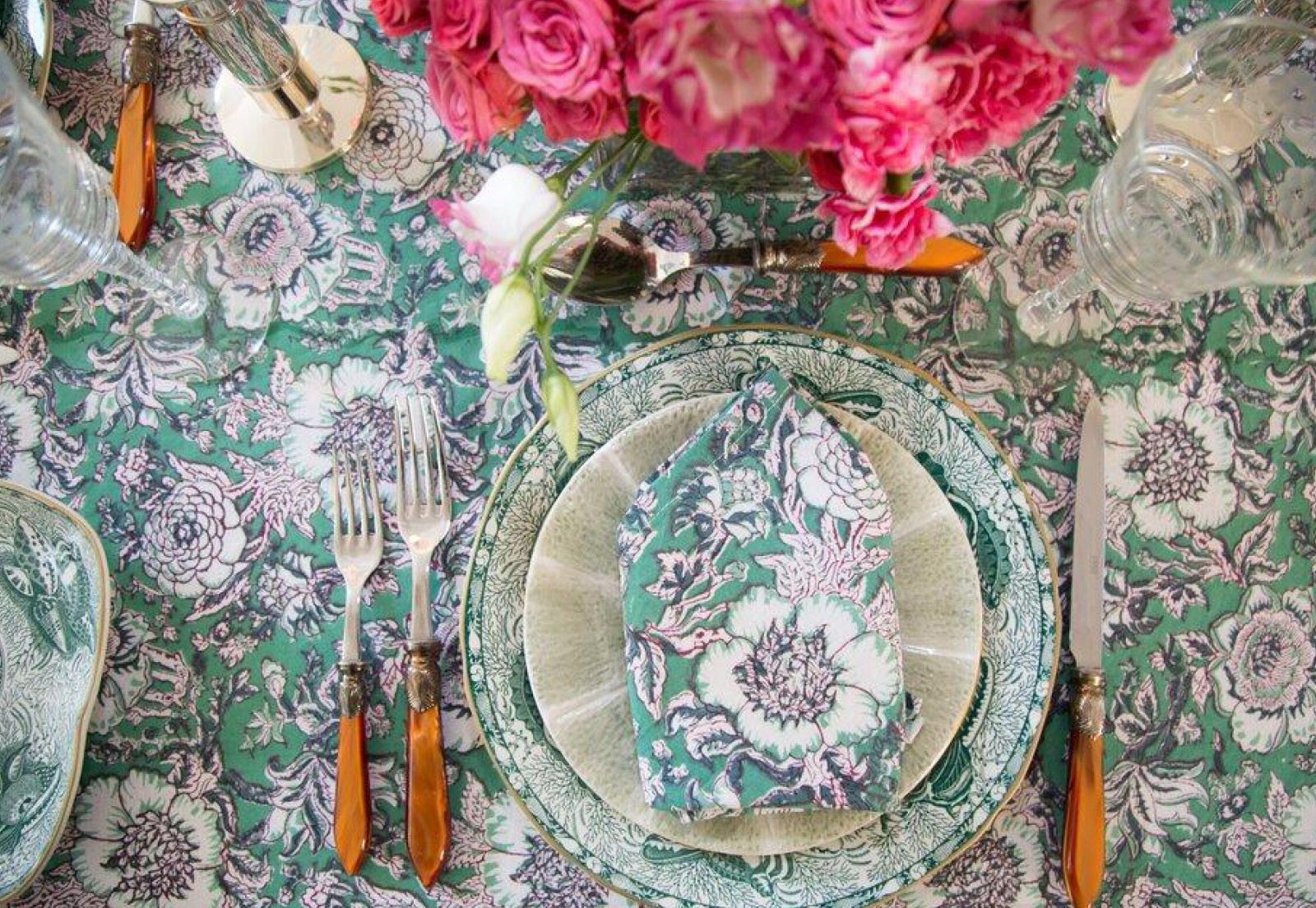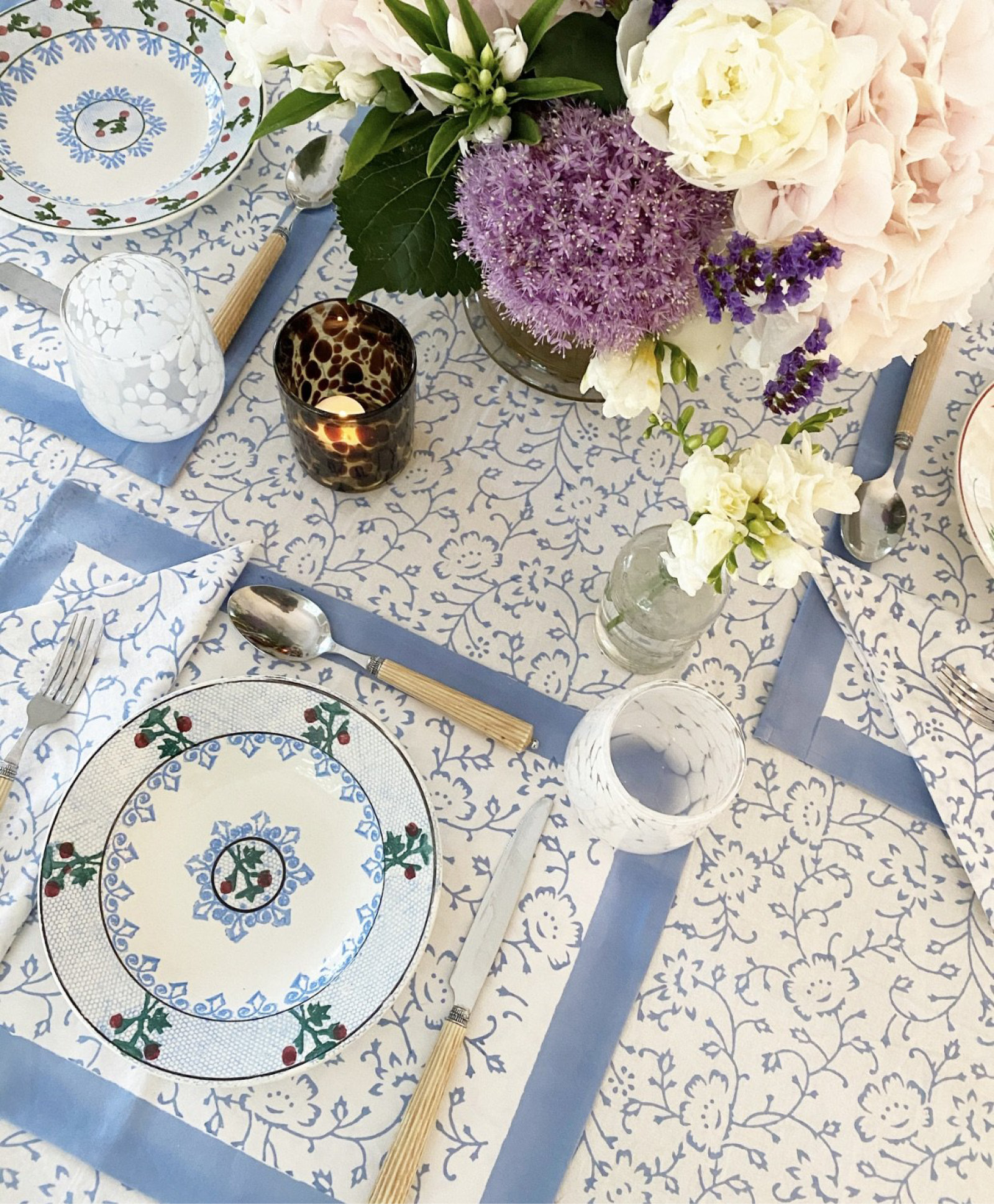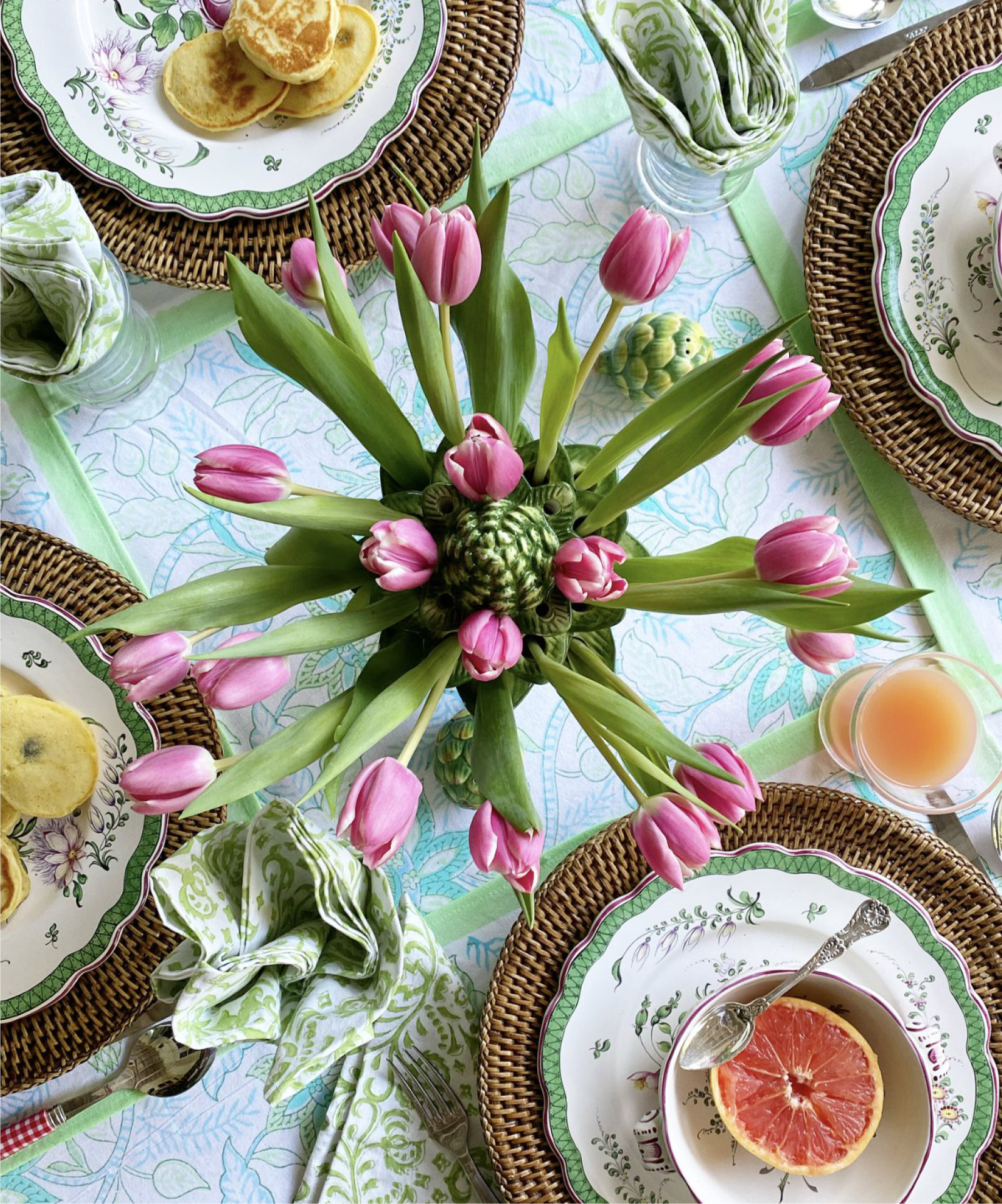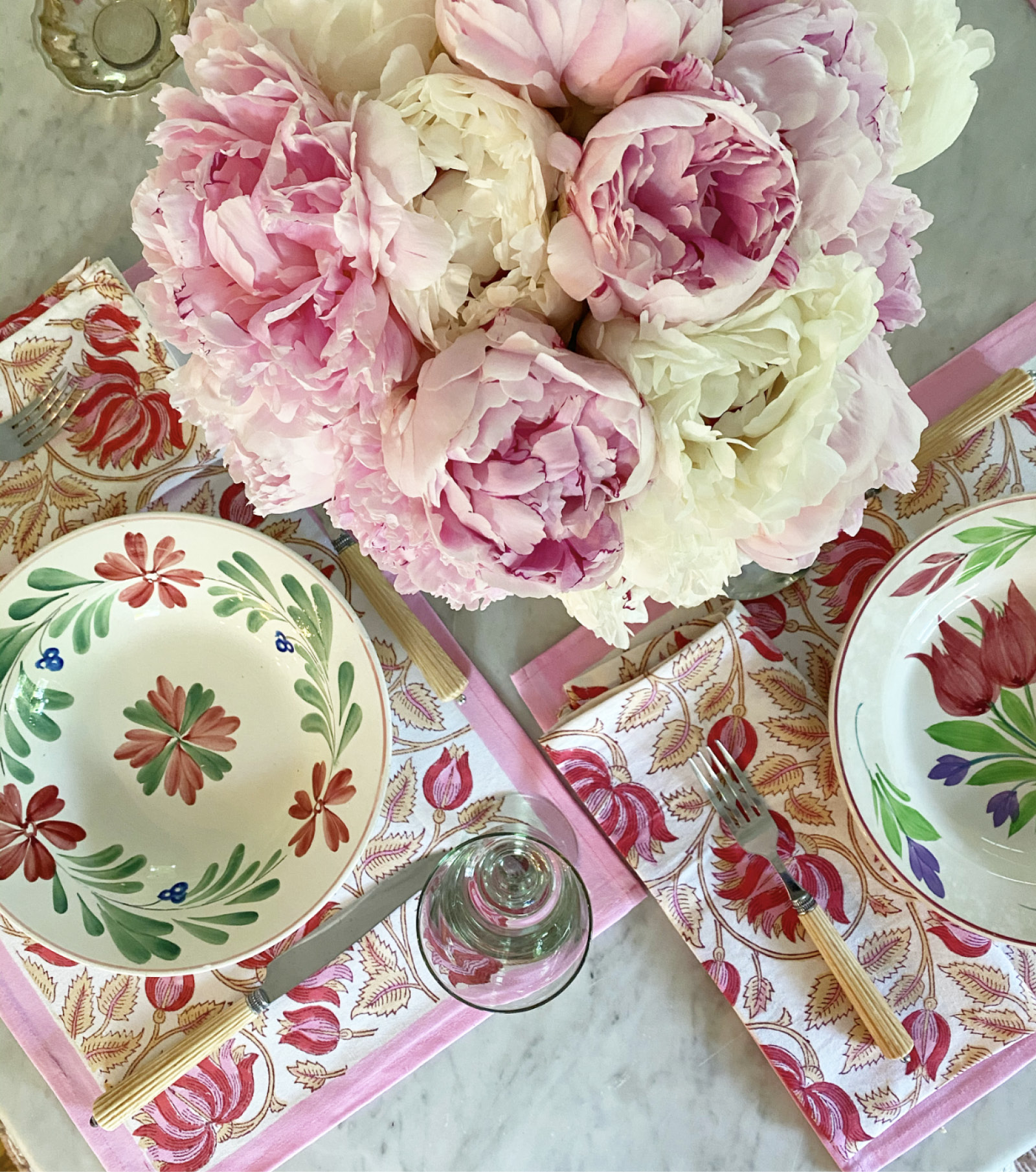
Give me the assignment of ranking which I love more, flowy dresses or beautiful table settings, and I’ll likely earn an incomplete. The reality is, my heart beats strong for all things beautiful.
My pulse took an especially rapid uptick when I discovered India Amory a few years back. The Hamptons-based lifestyle brand floods Instagram with inspiring pictures that feature its colorful hand-blocked patterns realized by artists and craftspeople in India. Whether it’s a dress that I can imagine myself wearing on a trip to Palm Beach or a tablecloth that I’d drape over my table for lunch with my family, I’m sold.
I was excited to speak with Julia Amory, the founder of the brand, about her pivot from the corporate world of finance to design, color, pattern, and style.

I’m always intrigued by corporate movers and shakers who make their way to fabric swatches and paint decks. What led you to a career that’s rooted in artistry?
I’ve always been interested in design. I grew up in a family of decorators and always gravitated toward it.
How did you land on the name?
Pretty simple. India is where all of my goods are produced. Amory is my last name. It’s funny because so many people who I meet assume that my name is India.
Isn’t it true, that India Amory started with “I do”?
You are so right. When I launched India Amory, it focused on wedding elements. During my own wedding planning in 2015, I got back in touch with my love of design. I couldn’t find anyone who stocked enough good-looking round tablecloths as rentals. I entertained the idea of buying designer fabrics and having tablecloths made, but the cost was astronomical. I began exploring more cost-efficient options and realized that block print was customizable and affordable. I drew out a pattern, sent it to a contact in India, and a month later 25 cloths arrived. I also did robes for the bridesmaids. Then on our honeymoon, the business idea was born. I had been working in investment banking for almost seven years and knew it would not be included in the next chapter of my life.

People who have left the corporate world for a career in creativity, often express an appreciation for the business knowledge that you gleaned from a structured environment. Why is that so important?
I’m incredibly lucky that I’ve had the background of corporate. The success of my business is a serendipitous convergence from the years that I put in within that setting.
For those who have an entrepreneurial itch and believe that convenient online tools, and oftentimes free tools, allow you to circumvent business principles need to take a step back. You need the necessary experience to properly set the foundation of a business plus blood, sweat, and tears. All of those online tools such as Shopify and Squarespace are wonderful. They allow entrepreneurs to build a business without incurring traditional overhead costs. But if not used properly, the voice gets lost in the herd.

How did that corporate upbringing shape you?
I started my career in an industry that was 24/7 all day, every day. And what you put into it is what you got out of it. I am inherently a hard worker. But my work ethic was honed to finish everything that I put on my to-do list. In investment banking, there was definitely a “no crying in baseball” attitude. Being disciplined or putting yourself through SWAT training where people have high expectations and accountability is important. That’s what trained me to learn to finish what I start, learn to respond to emails, all of those details that aren’t necessarily associated with an artistic profession. But I brought those business fundamentals with me as I started my business, and I believe that’s what has helped make it what it is.
Let’s talk Instagram and social media in general. It’s been an incredible outlet to show your product. How do you use it and how do you not?
I make myself an integral part of the brand. To keep my voice consistent, I try not to post content that stretches beyond the scope of the products that we sell. There are people who do that. But my secret sauce is the seamless blend between who I am and what I do. That voice makes the brand and myself approachable. I love when people DM me asking questions about what to pair with what. My voice and presence lead to engagement with my audience.

People love to know what products the style setters they follow are buying. You don’t link other products. Why?
I’m always happy to serve as inspiration. But it’s important to visually absorb an idea and pull elements that you are attracted to without copying. That’s just not interesting. It’s better to go on the hunt for product and find pieces to fit into a look rather than repeating what’s been done. In order for people to understand their own style, they need to ask questions. What is it about the Instagram picture that you like? What is the visual attraction? Is it the color? A silhouette? Asking questions of yourself helps develop your own personal aesthetic. It’s about learning what you like and what excites you versus being told what to like by someone who is being paid to do so.
How have you identified your own style?
So much of it came through my upbringing. I have grown up in homes that have really beautiful appreciation for antiques. Because of that, I’m OK with having something that’s visually a little off. I don’t want my look to be precious or perfect, rather grab-and-go. If it’s too precious and too perfect, it loses visual interest. I rarely start from scratch. I usually have something to start from that guides the rest. Alexandra Stoddard, the famed author and interior designer, was married to my grandfather, and she shaped much of my visual preferences.

Table linens are a major part of your business. There’s been a growing mindfulness about being together more and making time to eat together as a family. COVID catapulted that idea into reality. What are your thoughts about this renewed activity of eating together at home again?
I grew up in a family that valued dinner together every night. We ate breakfast together before school too. My dad is from Europe and loves tradition and ritual. I’m thrilled that people are establishing stability by being together again. It’s important to learn the act of being present—creating a reassuring moment by doing something intentionally.
Setting a table is a great exercise in creativity. The reality is, as much as people love design, it’s not necessarily something that makes sense to do every day. But you can set a table every day, and it can be relatively inexpensive to do it a little differently.
The silver lining to a challenging year is that we can flex our creative muscles. I’m hoping that the trend to eat together at home continues. My audience is 50/50 older women who have more of an attachment to setting a table and a large base of young women in their first apartment who really enjoy nesting and making their homes beautiful. A tablecloth topped with plates, a few candles, and flowers is simple. It doesn’t have to be complex. In the end, the goal is to put the table together as a family, and that’s really lovely.
India Amory is full of lovely ideas and products. Hop over to the site to fill your day with beauty.


